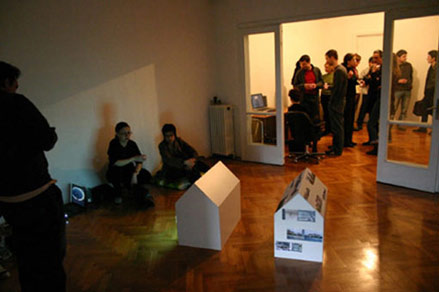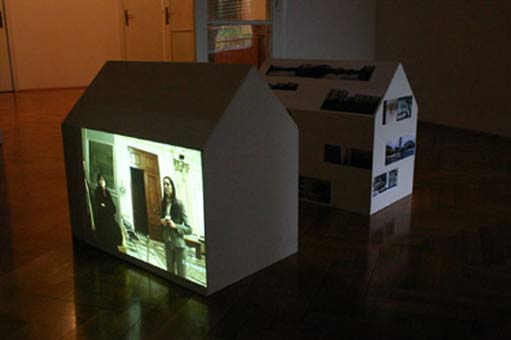THE PALACE/ PERSEPOLIS
Mona Vatamanu & Florin Tudor
2020 Home Gallery - 14 April 2004
Artists statement
The Palace
Imagine you are living in Romania. We grew up here whilst our cities, Bucharest and Constanta were demolished to make room for the socialist utopia. After that, a large part of Romanians found themselves living in cities of blocks of flats.
The palace was left unfinished by his owner, killed in 1989. The guided tour tells his story and the story of the building and the social implications on the lives of the people living in Bucharest.
We don't know how to consider our action of filming there _ Diana, the guide, was acting like a performer acting a role reminding us of Lara Croft's character in Tomb Rider, at the same time her discourse was hardly covering the drama of having the palace here… We can't describe the horrific dimension that this building represents for us, maybe ridiculous, incoherent, absurd, aggressive could be the words.
The border between filming legal or forbidden things inside is very thin because the edifice now hosts the parliament and at the same time you are allowed to tape by paying a fee of € 9. Another weird thing for us is that if you live in Bucharest you cannot figure out the amount of material wasted there until you visit the palace just like foreign tourists. It is like in a city of socialist blocks where you can find a palace made from socialist blocks.
We kept the footage like character of the film to make the viewer feel more as a tourist inside since in Bucharest this place is mostly visited by foreign tourists.
After the first film we made a second
one with a different guide. Not surprisingly this one is different in
discourse and story from the first revealing the contradictions in
Romanian society. An installation with both could work as a space for
experiencing a post-traumatic situation.
Persepolis
Persepolis is another stage (after living units/Budapest) in studying post-socialist living, this time in Bucharest. The concept is that Bucharest has inside patterns of constructed utopia superimposed with no serious urban planning so each period was somehow aggressive on the previous layers. We are processing these patterns of architecture.
One of the most aggressive ways of constructing by destroying the city was the socialist layer, and now, 20/40 years later, we see large areas of blocks of flats slowly transforming themselves into debris. They lost the ideology that created them but a lot of people still inhabit inside, using socialist designed "machines a habiter".
Some nuances can be noticed in the way that serial blocks of flats are considered now. We will mention two situations: one is the case of large boulevards with inserts of modernist monoliths in the center of the city which is still very intense and traumatic and you can see how the original abstract design of the modernist facades is slowly changed and destroyed by the interventions of the inhabitants; the other is a large number of blocks around the lake and park called IOR where these constructions integrate in the romantic landscape just like in a historical landscape painting and people there seem not to be aggressed by socialist utopia.
The interaction between the blocks of flats and their inhabitants can be seen mainly on the facade where the balconies became shortly after 1990, an experimental ground for the owner and after a first functionalist period when the balcony was used to deposit all kind of things or food now become for many a new room or office...
Maybe related to this esthetical need,
a new kind of architecture appeared during the last few years.
Hotel Persepolis (http://www.bucharestpersepolis.ro/)
is just an example of local luxury. It is located in Pipera in a neighborhood
of weird new architecture partly issued from plans of respected architects
but the general result is exotic and chaotic. Seeing this hotel in a
pure mesopotamiam style with double headed horses as statues in front
is a special experience. We have to mention here that the whole area
is guarded because a lot of American, British, French personal from
embassies along with foreign and Romanian investors are living there,
so the simple fact of taking photos there ends by giving your name and
coordinates to special forces protecting the people in the frame of
the global war on terror...
Another interesting layer in Bucharest is new architecture, and there is a location where a lot of buildings will be constructed this year acting just like a testing ground for future developments of the city. One of the construction sites is called "cascade" a project by DSBA and the architect in charge is Dan Dinoiu. We started to record the stages of the construction 3 months ago and we try to take advantage to see utopia at work...
Just like before the Second World War,
today architecture is generated by economic needs but unlike the previous
socialist period architects have a different approach to utopia.
Dan said one day something like a statement there is no architecture
without utopia.
Maybe because of this we where so interested in recording the building
of a new thing, another one added to the previous urban tissue.
mona vatamanu & florin tudor
For more information about Mona and Florin's work check www.exapes.org
 |

|

|